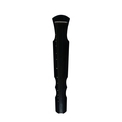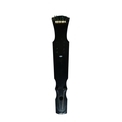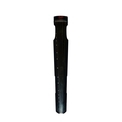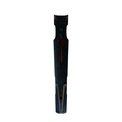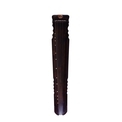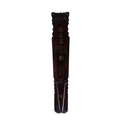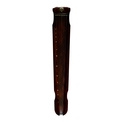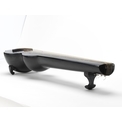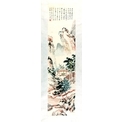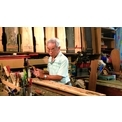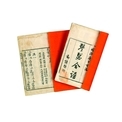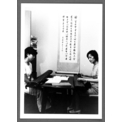Tools used in the fifth step of qin making process
Tools and materials used in the fifth step of qin making process – assembling:
(1)Raw lacquer – to be mixed with flour to form an adhesive
(2)Flour – to be mixed with raw lacquer to form an adhesive
(3)Animal gum – to be melted in a double boiler and used as an adhesive
(4)Bamboo nails – made of old bamboo, each nail is about 2-3cm long. They are used to hold together the boards of a qin. They do not rust like metal ones in humid weather, and will not hurt the qin body.
(5)Drill – holes are first drilled on the qin bottom at suitable positions and then the bamboo nails are inserted into the holes. This prevents the bamboo nails from breaking off.
(6)Hammer – used for hitting the nails into the qin body
(7)Linen cloth – used for tightening the qin body, as well as for preventing the lacquer on the qin top from warping and cracking
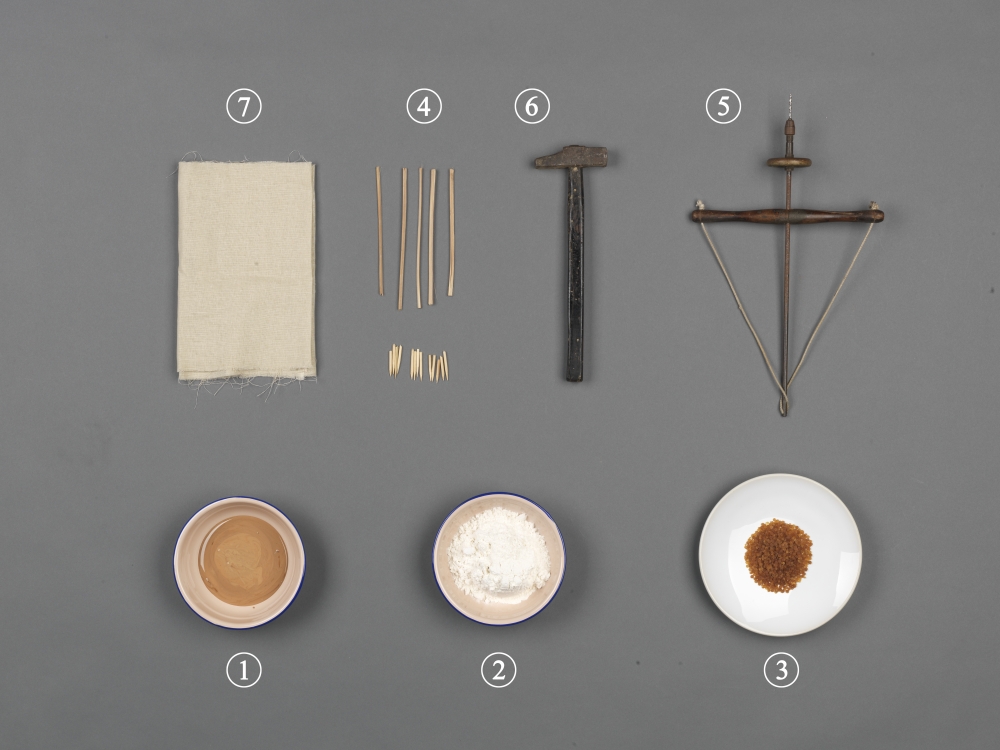
| Date | 2013 |
| Material Type | Image |
| Collection | The Legend of Silk and Wood: A Hong Kong Qin Story |
| Source | Intangible Cultural Heritage Office and Hong Kong Heritage Museum |
| Repository | Intangible Cultural Heritage Office |
| Note to Copyright | Permission for use in Hong Kong Memory is given by Intangible Cultural Heritage Office and Hong Kong Heritage Museum |
| Accession No. | lcs-hkqs-0113 |
Tools used in the fifth step of qin making process
Tools and materials used in the fifth step of qin making process – assembling:
(1)Raw lacquer – to be mixed with flour to form an adhesive
(2)Flour – to be mixed with raw lacquer to form an adhesive
(3)Animal gum – to be melted in a double boiler and used as an adhesive
(4)Bamboo nails – made of old bamboo, each nail is about 2-3cm long. They are used to hold together the boards of a qin. They do not rust like metal ones in humid weather, and will not hurt the qin body.
(5)Drill – holes are first drilled on the qin bottom at suitable positions and then the bamboo nails are inserted into the holes. This prevents the bamboo nails from breaking off.
(6)Hammer – used for hitting the nails into the qin body
(7)Linen cloth – used for tightening the qin body, as well as for preventing the lacquer on the qin top from warping and cracking

| Date | 2013 |
| Material Type | Image |
| Collection | The Legend of Silk and Wood: A Hong Kong Qin Story |
| Source | Intangible Cultural Heritage Office and Hong Kong Heritage Museum |
| Repository | Intangible Cultural Heritage Office |
| Note to Copyright | Permission for use in Hong Kong Memory is given by Intangible Cultural Heritage Office and Hong Kong Heritage Museum |
| Accession No. | lcs-hkqs-0113 |
Tools used in the fifth step of qin making process
Tools and materials used in the fifth step of qin making process – assembling:
(1)Raw lacquer – to be mixed with flour to form an adhesive
(2)Flour – to be mixed with raw lacquer to form an adhesive
(3)Animal gum – to be melted in a double boiler and used as an adhesive
(4)Bamboo nails – made of old bamboo, each nail is about 2-3cm long. They are used to hold together the boards of a qin. They do not rust like metal ones in humid weather, and will not hurt the qin body.
(5)Drill – holes are first drilled on the qin bottom at suitable positions and then the bamboo nails are inserted into the holes. This prevents the bamboo nails from breaking off.
(6)Hammer – used for hitting the nails into the qin body
(7)Linen cloth – used for tightening the qin body, as well as for preventing the lacquer on the qin top from warping and cracking

| Date | 2013 |
| Material Type | Image |
| Collection | The Legend of Silk and Wood: A Hong Kong Qin Story |
| Source | Intangible Cultural Heritage Office and Hong Kong Heritage Museum |
| Repository | Intangible Cultural Heritage Office |
| Note to Copyright | Permission for use in Hong Kong Memory is given by Intangible Cultural Heritage Office and Hong Kong Heritage Museum |
| Accession No. | lcs-hkqs-0113 |
Tools used in the fifth step of qin making process
Tools and materials used in the fifth step of qin making process – assembling:
(1)Raw lacquer – to be mixed with flour to form an adhesive
(2)Flour – to be mixed with raw lacquer to form an adhesive
(3)Animal gum – to be melted in a double boiler and used as an adhesive
(4)Bamboo nails – made of old bamboo, each nail is about 2-3cm long. They are used to hold together the boards of a qin. They do not rust like metal ones in humid weather, and will not hurt the qin body.
(5)Drill – holes are first drilled on the qin bottom at suitable positions and then the bamboo nails are inserted into the holes. This prevents the bamboo nails from breaking off.
(6)Hammer – used for hitting the nails into the qin body
(7)Linen cloth – used for tightening the qin body, as well as for preventing the lacquer on the qin top from warping and cracking

| Date | 2013 |
| Material Type | Image |
| Collection | The Legend of Silk and Wood: A Hong Kong Qin Story |
| Source | Intangible Cultural Heritage Office and Hong Kong Heritage Museum |
| Repository | Intangible Cultural Heritage Office |
| Note to Copyright | Permission for use in Hong Kong Memory is given by Intangible Cultural Heritage Office and Hong Kong Heritage Museum |
| Accession No. | lcs-hkqs-0113 |
Tools used in the fifth step of qin making process
Tools and materials used in the fifth step of qin making process – assembling:
(1)Raw lacquer – to be mixed with flour to form an adhesive
(2)Flour – to be mixed with raw lacquer to form an adhesive
(3)Animal gum – to be melted in a double boiler and used as an adhesive
(4)Bamboo nails – made of old bamboo, each nail is about 2-3cm long. They are used to hold together the boards of a qin. They do not rust like metal ones in humid weather, and will not hurt the qin body.
(5)Drill – holes are first drilled on the qin bottom at suitable positions and then the bamboo nails are inserted into the holes. This prevents the bamboo nails from breaking off.
(6)Hammer – used for hitting the nails into the qin body
(7)Linen cloth – used for tightening the qin body, as well as for preventing the lacquer on the qin top from warping and cracking

| Date | 2013 |
| Material Type | Image |
| Collection | The Legend of Silk and Wood: A Hong Kong Qin Story |
| Source | Intangible Cultural Heritage Office and Hong Kong Heritage Museum |
| Repository | Intangible Cultural Heritage Office |
| Note to Copyright | Permission for use in Hong Kong Memory is given by Intangible Cultural Heritage Office and Hong Kong Heritage Museum |
| Accession No. | lcs-hkqs-0113 |
Tools used in the fifth step of qin making process
Tools and materials used in the fifth step of qin making process – assembling:
(1)Raw lacquer – to be mixed with flour to form an adhesive
(2)Flour – to be mixed with raw lacquer to form an adhesive
(3)Animal gum – to be melted in a double boiler and used as an adhesive
(4)Bamboo nails – made of old bamboo, each nail is about 2-3cm long. They are used to hold together the boards of a qin. They do not rust like metal ones in humid weather, and will not hurt the qin body.
(5)Drill – holes are first drilled on the qin bottom at suitable positions and then the bamboo nails are inserted into the holes. This prevents the bamboo nails from breaking off.
(6)Hammer – used for hitting the nails into the qin body
(7)Linen cloth – used for tightening the qin body, as well as for preventing the lacquer on the qin top from warping and cracking

| Date | 2013 |
| Material Type | Image |
| Collection | The Legend of Silk and Wood: A Hong Kong Qin Story |
| Source | Intangible Cultural Heritage Office and Hong Kong Heritage Museum |
| Repository | Intangible Cultural Heritage Office |
| Note to Copyright | Permission for use in Hong Kong Memory is given by Intangible Cultural Heritage Office and Hong Kong Heritage Museum |
| Accession No. | lcs-hkqs-0113 |
Tools used in the fifth step of qin making process
Tools and materials used in the fifth step of qin making process – assembling:
(1)Raw lacquer – to be mixed with flour to form an adhesive
(2)Flour – to be mixed with raw lacquer to form an adhesive
(3)Animal gum – to be melted in a double boiler and used as an adhesive
(4)Bamboo nails – made of old bamboo, each nail is about 2-3cm long. They are used to hold together the boards of a qin. They do not rust like metal ones in humid weather, and will not hurt the qin body.
(5)Drill – holes are first drilled on the qin bottom at suitable positions and then the bamboo nails are inserted into the holes. This prevents the bamboo nails from breaking off.
(6)Hammer – used for hitting the nails into the qin body
(7)Linen cloth – used for tightening the qin body, as well as for preventing the lacquer on the qin top from warping and cracking

| Date | 2013 |
| Material Type | Image |
| Collection | The Legend of Silk and Wood: A Hong Kong Qin Story |
| Source | Intangible Cultural Heritage Office and Hong Kong Heritage Museum |
| Repository | Intangible Cultural Heritage Office |
| Note to Copyright | Permission for use in Hong Kong Memory is given by Intangible Cultural Heritage Office and Hong Kong Heritage Museum |
| Accession No. | lcs-hkqs-0113 |
Tools used in the fifth step of qin making process
Tools and materials used in the fifth step of qin making process – assembling:
(1)Raw lacquer – to be mixed with flour to form an adhesive
(2)Flour – to be mixed with raw lacquer to form an adhesive
(3)Animal gum – to be melted in a double boiler and used as an adhesive
(4)Bamboo nails – made of old bamboo, each nail is about 2-3cm long. They are used to hold together the boards of a qin. They do not rust like metal ones in humid weather, and will not hurt the qin body.
(5)Drill – holes are first drilled on the qin bottom at suitable positions and then the bamboo nails are inserted into the holes. This prevents the bamboo nails from breaking off.
(6)Hammer – used for hitting the nails into the qin body
(7)Linen cloth – used for tightening the qin body, as well as for preventing the lacquer on the qin top from warping and cracking

| Date of Death | 2013 |
| Material Type | Image |
| Collection | The Legend of Silk and Wood: A Hong Kong Qin Story |
| Source | Intangible Cultural Heritage Office and Hong Kong Heritage Museum |
| Repository | Intangible Cultural Heritage Office |
| Note to Copyright | Permission for use in Hong Kong Memory is given by Intangible Cultural Heritage Office and Hong Kong Heritage Museum |
| Accession No. | lcs-hkqs-0113 |
Tools used in the fifth step of qin making process
Tools and materials used in the fifth step of qin making process – assembling:
(1)Raw lacquer – to be mixed with flour to form an adhesive
(2)Flour – to be mixed with raw lacquer to form an adhesive
(3)Animal gum – to be melted in a double boiler and used as an adhesive
(4)Bamboo nails – made of old bamboo, each nail is about 2-3cm long. They are used to hold together the boards of a qin. They do not rust like metal ones in humid weather, and will not hurt the qin body.
(5)Drill – holes are first drilled on the qin bottom at suitable positions and then the bamboo nails are inserted into the holes. This prevents the bamboo nails from breaking off.
(6)Hammer – used for hitting the nails into the qin body
(7)Linen cloth – used for tightening the qin body, as well as for preventing the lacquer on the qin top from warping and cracking

| Date | 2013 |
| Material Type | Image |
| Collection | The Legend of Silk and Wood: A Hong Kong Qin Story |
| Source | Intangible Cultural Heritage Office and Hong Kong Heritage Museum |
| Note to Copyright | Permission for use in Hong Kong Memory is given by Intangible Cultural Heritage Office and Hong Kong Heritage Museum |
| Accession No. | lcs-hkqs-0113 |
Tools used in the fifth step of qin making process
Tools and materials used in the fifth step of qin making process – assembling:
(1)Raw lacquer – to be mixed with flour to form an adhesive
(2)Flour – to be mixed with raw lacquer to form an adhesive
(3)Animal gum – to be melted in a double boiler and used as an adhesive
(4)Bamboo nails – made of old bamboo, each nail is about 2-3cm long. They are used to hold together the boards of a qin. They do not rust like metal ones in humid weather, and will not hurt the qin body.
(5)Drill – holes are first drilled on the qin bottom at suitable positions and then the bamboo nails are inserted into the holes. This prevents the bamboo nails from breaking off.
(6)Hammer – used for hitting the nails into the qin body
(7)Linen cloth – used for tightening the qin body, as well as for preventing the lacquer on the qin top from warping and cracking

| Date | 2013 |
| Material Type | Image |
| Collection | The Legend of Silk and Wood: A Hong Kong Qin Story |
| Source | Intangible Cultural Heritage Office and Hong Kong Heritage Museum |
| Repository | Intangible Cultural Heritage Office |
| Note to Copyright | Permission for use in Hong Kong Memory is given by Intangible Cultural Heritage Office and Hong Kong Heritage Museum |
| Accession No. | lcs-hkqs-0113 |


